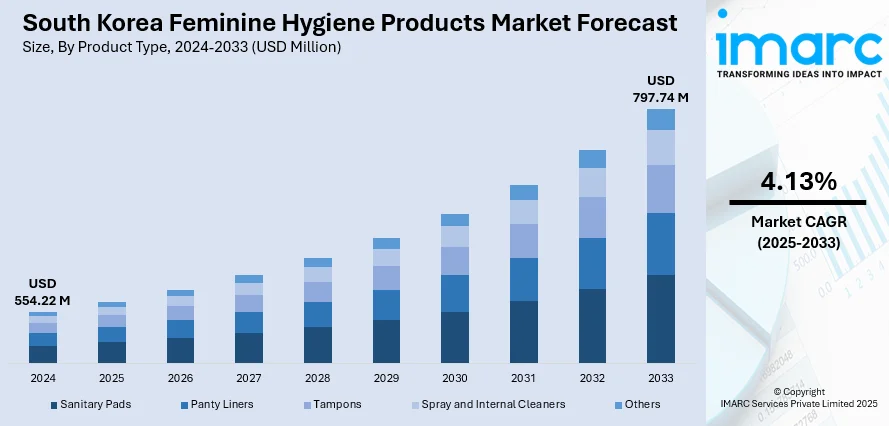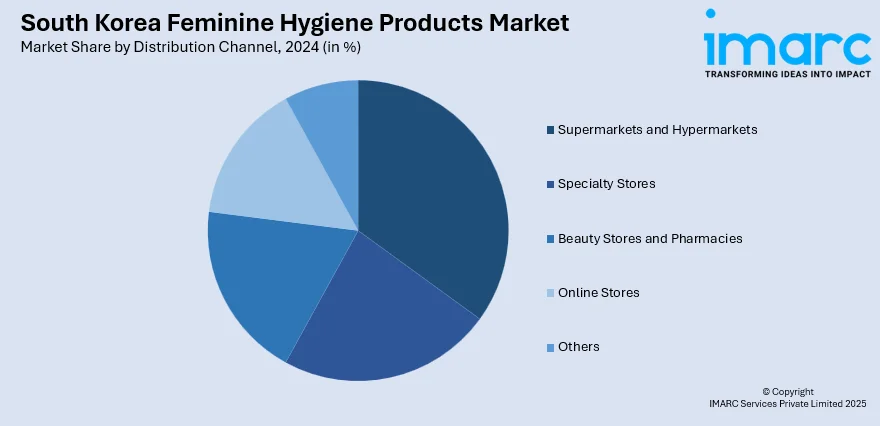
South Korea Feminine Hygiene Products Market Size, Share, Trends and Forecast by Product Type, Distribution Channel, and Region, 2025-2033
South Korea Feminine Hygiene Products Market Overview:
The South Korea feminine hygiene products market size reached USD 554.22 Million in 2024. Looking forward, IMARC Group expects the market to reach USD 797.74 Million by 2033, exhibiting a growth rate (CAGR) of 4.13% during 2025-2033. The feminine hygiene market is propelled by the growing e-commerce use, which is enabling personalized engagement and wider product access. Moreover, shifting age demographics is catalyzing the demand for specialized products across all life stages, ranging from adolescence to menopause, driving innovation, increasing market opportunities, and contributing to the South Korea feminine hygiene products market share.
|
Report Attribute
|
Key Statistics
|
|---|---|
|
Base Year
|
2024 |
|
Forecast Years
|
2025-2033
|
|
Historical Years
|
2019-2024
|
| Market Size in 2024 | USD 554.22 Million |
| Market Forecast in 2033 | USD 797.74 Million |
| Market Growth Rate 2025-2033 | 4.13% |
South Korea Feminine Hygiene Products Market Trends:
E-Commerce Growth and Digital User Engagement
As one of the most digitally connected societies, people in South Korea are increasingly turning to online platforms for the convenience, privacy, and expansive selection they offer. E-commerce websites, mobile apps, and social media platforms allow brands to engage directly with their target audiences, refine marketing strategies through personalized content, and collect valuable user feedback in real time. Additionally, digital spaces are creating new opportunities for subscription-based services and direct-to-consumer (DTC) brands, which offer recurring deliveries and tailored product offerings, especially appealing to busy, health-conscious individuals. Moreover, the low entry barrier of digital marketplaces is enabling smaller and niche brands to reach buyers by emphasizing unique lifestyle values, such as sustainability or clean beauty. This digital shift is underscored by data from Statistics Korea, which reported that online shopping transaction value reached 18.9766 trillion won in February 2024, reflecting an 11.0% increase from February 2023. Such growth illustrates the accelerating user preference for online retail, including feminine hygiene products. This digital momentum is not only boosting accessibility and product diversity but also intensifying competition and innovation across the feminine hygiene sector in South Korea.

To get more information on this market, Request Sample
Shifting Age Demographics and Lifecycle Needs
The evolving population structure is influencing the South Korea feminine hygiene products market growth through changing age dynamics and lifecycle-related demands. The market is diverse, catering to individuals across all stages of reproductive health, ranging from teenagers beginning menstruation to older women navigating perimenopause and menopause. Notably, according to the 2024 Statistics on the Aged, individuals aged 65 and older already make up 19.2% of the population, a figure expected to exceed 20% in 2025 and reach 30% by 2036. As this age group grows, so does the need for tailored feminine hygiene solutions that cater to mature women. This demographic complexity creates demand for specialized products that address varied concerns such as comfort, skin sensitivity, hormonal shifts, and urinary hygiene. Teen-focused offerings often emphasize education, ease of use, and discretion, while products for older women highlight gentler materials and enhanced protection. The growing need for age-appropriate hygiene solutions also encourages brands to broaden their scope, integrating products for postpartum care, daily freshness, and non-menstrual wellness. This lifecycle-based approach enables companies to build long-term client relationships and foster loyalty across different age groups.
South Korea Feminine Hygiene Products Market Segmentation:
IMARC Group provides an analysis of the key trends in each segment of the market, along with forecasts at the country and regional levels for 2025-2033. Our report has categorized the market based on product type and distribution channel.
Product Type Insights:
- Sanitary Pads
- Panty Liners
- Tampons
- Spray and Internal Cleaners
- Others
The report has provided a detailed breakup and analysis of the market based on the product type. This includes sanitary pads, panty liners, tampons, spray and internal cleaners, and others.
Distribution Channel Insights:

- Supermarkets and Hypermarkets
- Specialty Stores
- Beauty Stores and Pharmacies
- Online Stores
- Others
A detailed breakup and analysis of the market based on the distribution channel have also been provided in the report. This includes supermarkets and hypermarkets, specialty stores, beauty stores and pharmacies, online stores, and others.
Regional Insights:
- Seoul Capital Area
- Yeongnam (Southeastern Region)
- Honam (Southwestern Region)
- Hoseo (Central Region)
- Others
The report has also provided a comprehensive analysis of all the major regional markets, which include Seoul Capital Area, Yeongnam (Southeastern Region), Honam (Southwestern Region), Hoseo (Central Region), and others.
Competitive Landscape:
The market research report has also provided a comprehensive analysis of the competitive landscape. Competitive analysis such as market structure, key player positioning, top winning strategies, competitive dashboard, and company evaluation quadrant has been covered in the report. Also, detailed profiles of all major companies have been provided.
South Korea Feminine Hygiene Products Market News:
- In February 2025, South Korea's Yuhan Kimberly brand Good Feel launched a new sanitary pad with a "100% organic pure cotton cover." Made with pesticide-free cotton and vegan materials, it features enhanced absorption and comfort. The product will debut on Naver Shopping Live on February 24.
South Korea Feminine Hygiene Products Market Report Coverage:
| Report Features | Details |
|---|---|
| Base Year of the Analysis | 2024 |
| Historical Period | 2019-2024 |
| Forecast Period | 2025-2033 |
| Units | Million USD |
| Scope of the Report | Exploration of Historical Trends and Market Outlook, Industry Catalysts and Challenges, Segment-Wise Historical and Future Market Assessment:
|
| Product Types Covered | Sanitary Pads, Panty Liners, Tampons, Spray and Internal Cleaners, Others |
| Distribution Channels Covered | Supermarkets and Hypermarkets, Specialty Stores, Beauty Stores and Pharmacies, Online Stores, Others |
| Regions Covered | Seoul Capital Area, Yeongnam (Southeastern Region), Honam (Southwestern Region), Hoseo (Central Region), Others |
| Customization Scope | 10% Free Customization |
| Post-Sale Analyst Support | 10-12 Weeks |
| Delivery Format | PDF and Excel through Email (We can also provide the editable version of the report in PPT/Word format on special request) |
Key Questions Answered in This Report:
- How has the South Korea feminine hygiene products market performed so far and how will it perform in the coming years?
- What is the breakup of the South Korea feminine hygiene products market on the basis of product type?
- What is the breakup of the South Korea feminine hygiene products market on the basis of distribution channel?
- What is the breakup of the South Korea feminine hygiene products market on the basis of region?
- What are the various stages in the value chain of the South Korea feminine hygiene products market?
- What are the key driving factors and challenges in the South Korea feminine hygiene products market?
- What is the structure of the South Korea feminine hygiene products market and who are the key players?
- What is the degree of competition in the South Korea feminine hygiene products market?
Key Benefits for Stakeholders:
- IMARC’s industry report offers a comprehensive quantitative analysis of various market segments, historical and current market trends, market forecasts, and dynamics of the South Korea feminine hygiene products market from 2019-2033.
- The research report provides the latest information on the market drivers, challenges, and opportunities in the South Korea feminine hygiene products market.
- Porter's five forces analysis assist stakeholders in assessing the impact of new entrants, competitive rivalry, supplier power, buyer power, and the threat of substitution. It helps stakeholders to analyze the level of competition within the South Korea feminine hygiene products industry and its attractiveness.
- Competitive landscape allows stakeholders to understand their competitive environment and provides an insight into the current positions of key players in the market.
Need more help?
- Speak to our experienced analysts for insights on the current market scenarios.
- Include additional segments and countries to customize the report as per your requirement.
- Gain an unparalleled competitive advantage in your domain by understanding how to utilize the report and positively impacting your operations and revenue.
- For further assistance, please connect with our analysts.
 Request Customization
Request Customization
 Speak to an Analyst
Speak to an Analyst
 Request Brochure
Request Brochure
 Inquire Before Buying
Inquire Before Buying




.webp)




.webp)












